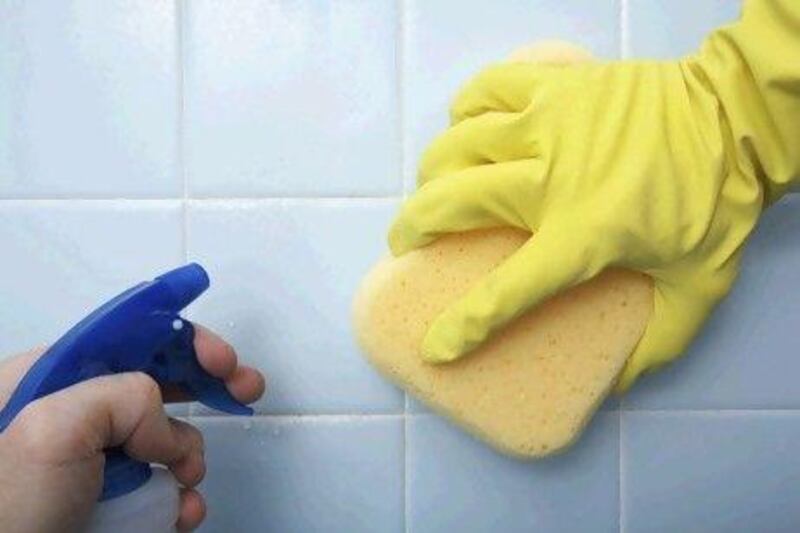What is mildew?
Mildew is a type of mould - a funguslike organism that thrives in moisture-rich environments and can grow on any damp, flat surface: ceilings, tile grout, window sills, walls and even floors.
The black mildew that is commonly found in bathrooms is usually stachybotrys chartarum. In large quantities it can cause health problems in both animals and people.
Not only does mildew look unsightly, it also produces a musty odour and, in unaired environments, can spread alarmingly quickly. Spores move through the air and can settle and grow on any surface that is damp enough.
Mildew grows quickly in warm, poorly aired rooms such as bathrooms and cellars, and it's a common problem in new builds because of moisture in the building materials.
How can I prevent it?
The most important thing to do is to reduce the moisture in the room. Mildew can't survive in a dry environment. There are many ways to do this.
It's often not practical to air a bathroom after every use, particularly if you are dashing off to work and need to leave your home secure with windows shut. But whenever you can, leave a window open immediately after a shower or bath for at least half an hour to let excess moisture evaporate and to air out the room.
If you live in one of the many homes in the UAE that doesn't have windows in the bathroom, make sure to turn your bathroom extractor fan on whenever possible. Check that your fan is working efficiently. If your fan is old or if the room is damp even with the fan on, it might be time to consider a newer, more powerful model.
If your home is a new build, be aware that a cheap and ineffective fan might have been installed, so shop around and consider upgrading to a pricier and more powerful one.
Avoid having very hot steamy showers or baths that can produce excess condensation, and try to shower quickly.
After a shower, allow the shower curtain to air by pulling it fully across the bath - and always dry towels or laundry thoroughly straight after use in a tumble drier or outside if possible.
Keep air conditioning on cooler settings. Cool air contains less moisture than warm air does, so turn your air conditioning down a notch.
Consider getting a dehumidifier to remove excess moisture from the air. Ensure it is safe to use in damp environments such as bathrooms and consult a professional electrician beforehand.
If space or budget is limited, stock up on small moisture-absorbing sachets such as Lakeland's Hanging Moisture Absorbers (Dh70). For a cheaper alternative, fill a jar with bicarbonate of soda crystals and put it on a shelf out of sight to absorb moisture in the air. Keep an eye on it and refill it regularly.
Never use electric fans in a bathroom or wet room, but in other rooms, electric fans can help to tackle the problem by circulating the air.
How can I tackle mildew once I've got it?
If you already have a mildew problem, it's time to take some immediate action. The longer you ignore the problem, the worse will get. Mildew can spread very quickly.
If the surface won't be damaged by a harsh chemical, wear a protective mask and gloves and wipe the affected areas with neat or diluted bleach to kill any spores and remove staining.
For plastic surfaces, tiles and wood, use a specialist product such as X-14 Professional Instant Mildew Stain Remover ($6.45 [Dh24] for 32oz, www.amazon.com). Use an old toothbrush to scrub badly-affected areas.
If your shower curtain is affected, check the washing instructions and, if appropriate, soak it in a mild bleach solution for 15 minutes to get rid of any marks and stains, then rinse the curtain thoroughly with cool water.
For seriously stained ceilings and walls, a simple wipe with a dry cloth and a fungicidal product (such as X-14, above) might kill the mildew but could leave behind unsightly dark marks. In this instance, it's best to redecorate. Choose a water-resistant paint that is suitable for damp kitchen or bathroom environments, and address the underlying problem of excess moisture in the air to prevent the same situation from arising again.
Items that are severely affected and cannot be cleaned, such as curtains, blinds or shower curtains, should be thrown away and replaced, since any remaining mildew spores could trigger another outbreak. Consider treating any new fabric items (such as blinds) in your bathroom with a fungicidal spray to prevent mildew from returning.
Daily duties
Squeegee Keep a squeegee in the shower and get rid of excess water droplets straight after washing.
Circulate Open the bathroom door after showering or bathing to allow air to circulate more easily and open several windows in your home to get a good blast of through-air.
Spray Spray tiles and seals after showering with a mild vinegar solution or a product such as Method Daily Shower Cleaner, $3.45 (Dh12.50) for 28 fl oz, www.amazon.com.
Dry Remove damp towels or laundry from the affected room and air or dry properly outside or in a dryer.





